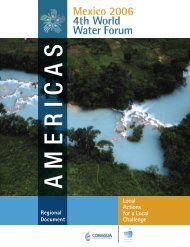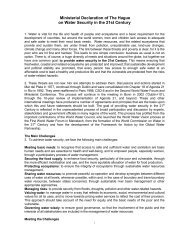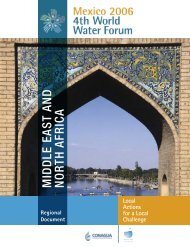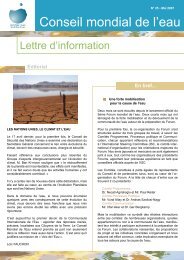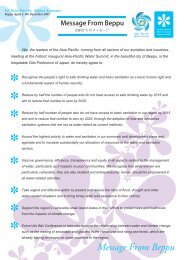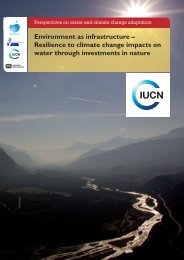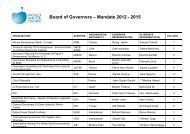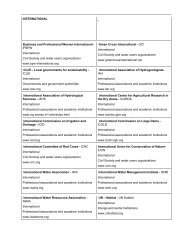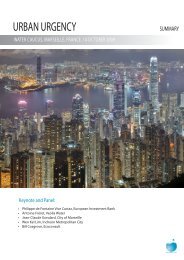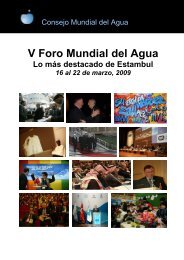the human right to water and sanitation in emergency situations
the human right to water and sanitation in emergency situations
the human right to water and sanitation in emergency situations
Create successful ePaper yourself
Turn your PDF publications into a flip-book with our unique Google optimized e-Paper software.
88<br />
Check<strong>in</strong>g <strong>in</strong>formation on <strong>water</strong> issues - “Accessibility <strong>in</strong>cludes <strong>the</strong> <strong>right</strong> <strong>to</strong> seek, receive <strong>and</strong> impart<br />
<strong>in</strong>formation concern<strong>in</strong>g <strong>water</strong> issues”<br />
- Are people aware of <strong>the</strong>ir legal <strong>right</strong>s? Are people aware of <strong>the</strong>ir own <strong>and</strong> o<strong>the</strong>r’s responsibilities?<br />
- Is <strong>in</strong>formation concern<strong>in</strong>g <strong>water</strong> issues available <strong>to</strong> all? How difficult is it <strong>to</strong> get hold of this <strong>in</strong>formation?<br />
Is <strong>in</strong>formation available <strong>in</strong> local languages spoken by <strong>the</strong> communities?<br />
- Do state authorities provide <strong>in</strong>formation on <strong>water</strong>? Do <strong>the</strong>y make sure that private companies provide<br />
such <strong>in</strong>formation?<br />
- Is <strong>the</strong> tariff system <strong>and</strong> <strong>the</strong> negotiation of tariffs transparent?<br />
Note that this table highlights <strong>the</strong> complexity of WASH-related delivery issues. In terms of advocacy, it is<br />
important for NGOs <strong>to</strong> avoid becom<strong>in</strong>g bogged down <strong>in</strong> m<strong>in</strong>utiae when referr<strong>in</strong>g <strong>to</strong> <strong>right</strong>s (e.g. for example<br />
assess<strong>in</strong>g what level of pric<strong>in</strong>g would constitute, or not, a violation of <strong>the</strong> <strong>right</strong> <strong>to</strong> <strong>water</strong>) <strong>and</strong> <strong>to</strong> rema<strong>in</strong> at<br />
an overall analytical level.<br />
14.2.3. Identification of victims<br />
Key question: Which population groups are affected by violations of <strong>the</strong>ir <strong>right</strong> <strong>to</strong> <strong>water</strong>?<br />
The victims of a violation of <strong>the</strong> <strong>right</strong> <strong>to</strong> <strong>water</strong> <strong>and</strong> <strong>sanitation</strong> need <strong>to</strong> be identified. Special attention must<br />
be paid <strong>to</strong> vulnerable groups <strong>and</strong> <strong>to</strong> cross-cutt<strong>in</strong>g issues such as gender, IDPs, HIV/AIDS, children, elderly<br />
people, <strong>the</strong> disabled, etc. It is also essential <strong>to</strong> f<strong>in</strong>d out how many people are affected by violations of <strong>the</strong>ir<br />
<strong>right</strong>s <strong>and</strong> where <strong>the</strong>y live which means that this stage will call for good background knowledge <strong>and</strong> familiarity<br />
with methods of evaluat<strong>in</strong>g <strong>the</strong> concept of vulnerability. An attempt will also be made <strong>to</strong> underst<strong>and</strong><br />
<strong>the</strong> effects of violations of <strong>the</strong> <strong>right</strong> <strong>to</strong> <strong>water</strong> on groups identified as “affected”.<br />
© ACF - THE HUMAN RIGHT TO WATER AND SANITATION IN EMERGENCY SITUATIONS



